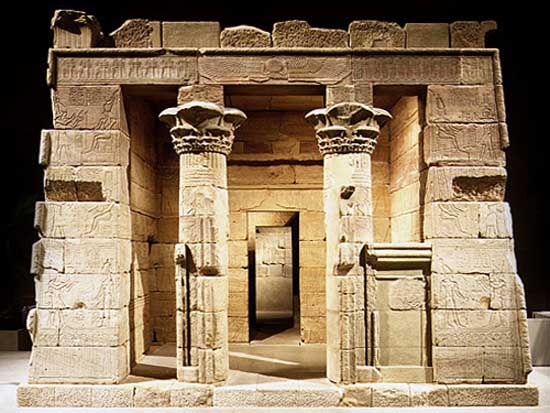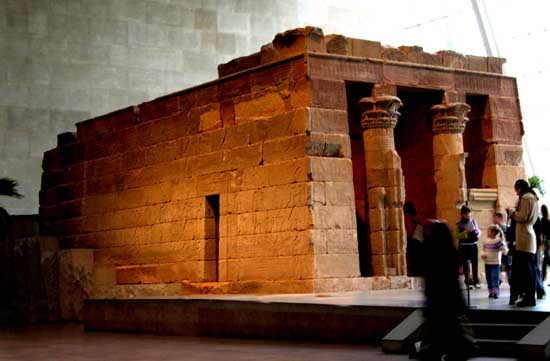
The collection of ancient Egyptian art at the Metropolitan Museum ranks
among the finest outside Cairo. It consists of approximately 36,000
objects of artistic, historical, and cultural importance, dating from
the Paleolithic to the Roman period (c. 300,000 BC–4th century AD). More
than half of the collection is derived from the Museum's thirty-five
years of archaeological work in Egypt, initiated in 1906 in response to
increasing public interest in the culture of ancient Egypt. Today,
virtually the entire collection is on display in thirty-two major
galleries and eight study galleries, with objects arranged
chronologically. Overall, the holdings reflect the aesthetic values,
history, religious beliefs, and daily life of the ancient Egyptians over
the entire course of their great civilization.
The Department of Egyptian Art is particularly well known for the Old
Kingdom mastaba (offering chapel) of Perneb (c. 2450 BC); a set of
Middle Kingdom wooden models from the tomb of Meketre at Thebes (c. 1990
BC); jewellery of Princess Sit-hathor-yunet of Dynasty 12 (c. 1897–1797
BC); royal portrait sculpture of 12th Dynasty (c.1991–1783 BC); and
statuary of the female pharaoh Hatshepsut of Dynasty 18 (c. 1473–1458
BC). The department also exhibits its invaluable collection of
watercolour facsimiles, most of which are copies of Theban tomb
paintings produced between 1907 and 1937 by members of the Graphic
Section of the Museum's Egyptian Expedition.
Highlights from the department are presented online in approximate
chronological order, and are identified by dynasty and/or period.
In some cases these are used on this site, as the text accompanying
those images.
The Museum's
web site is excellent. Where an image originated from the
Metropolitan site it is marked.
More about the Collection
The Department of Egyptian Art was established in 1906 to oversee
the Museum's already sizable collection of art from ancient Egypt. The
collection had been growing since 1874 thanks to individual gifts from
benefactors and acquisition of private collections (such as the Drexel
Collection in 1889, the Farman Collection in 1904, and the Ward
Collection in 1905), as well as through yearly subscriptions, from 1895
onward, to the Egypt Exploration Fund, a British organization that
conducted archaeological excavations in Egypt and donated a share of its
finds to subscribing institutions.
Also in 1906, the Museum's Board of Trustees voted to establish an
Egyptian Expedition to conduct archaeological excavations at several
sites along the Nile. Instrumental in this decision was J. Pierpont
Morgan, the Museum's president, who visited the expedition periodically
until his death in 1913. At the time, the Egyptian government (through
the Egyptian Antiquities Service) was granting foreign institutions the
right to excavate with the understanding that the resulting finds would
be divided fifty-fifty between the excavators and the Egyptian Museum in
Cairo. The Metropolitan Museum was granted concessions for the Middle
Kingdom royal cemeteries of Lisht, a site located on the west bank of
the Nile approximately thirty miles south of modern Cairo; the Late
Dynastic Period temple of Hibis at Kharga Oasis in the western desert;
the New Kingdom royal palace at Malkata; and the Middle and New Kingdom
cemeteries and temples of Deir el-Bahri in the Theban necropolis
opposite modern Luxor. Subsequently, the Egyptian Antiquities Service
granted access to other sites as well, among them the important
Predynastic cemetery of Hierakonpolis in southern Egypt.
Between 1906 and 1935, the Metropolitan Museum's Egyptian Expedition
conducted fourteen seasons of excavations at Lisht. The site includes
the Middle Kingdom pyramid complexes of Amenemhat I, the first king of
Dynasty 12, and of his son, Senwosret I; a cemetery of officials from
Dynasties 12 and 13; and an important Middle Kingdom settlement site.
The early excavation teams were led by noted American Egyptologist
Albert M. Lythgoe, the first curator of the Department of Egyptian Art.
Lythgoe was assisted by his American colleague, Ambrose Lansing, and by
Arthur C. Mace, a British Egyptologist. Also at Lisht was Herbert E.
Winlock, a young American who was just beginning his career in
Egyptology. Among the most important finds from the site are a ritual
figure of wood (c. 1929–1878 BC), one of a pair, the second of which is
in Cairo; and burial equipment from the tomb of the Lady Senebtisi. It
was while working with Mace in this tomb that Winlock developed the
careful archaeological methods that made him one of the greatest
excavators in the field of Egyptology.
In 1911, after several seasons at Lisht, Herbert Winlock became the
primary director of fieldwork at Thebes. He later succeeded Lythgoe as
the head of the Department of Egyptian Art, and eventually served as
director of the Museum. Winlock conducted excavations in the Dynasty 18
mud-brick palace of Amenhotep III at Malkata, near the southern end of
the vast Theban necropolis, but his principal work was done at the
temples and cemeteries in the area of Deir el-Bahri. There, in 1920, he
discovered a small, untouched chamber in the tomb of the early Middle
Kingdom chancellor Meketre (c. 1990 BC). The chamber contained a set of
twenty-four painted wooden models of boats, gardens, offering figures,
and scenes of food production that are more detailed than any found
before or since. Divided between the Egyptian Museum in Cairo and the
Metropolitan Museum in New York, these models are among the most prized
possessions of both collections.
Winlock also discovered hundreds of fragments of the smashed statues
that had once embellished the funerary temple of Hatshepsut, the great
female pharaoh who ruled during Dynasty 18 (c. 1473–1458 BC).
Painstakingly reassembled, these statues are some of the great
masterpieces now to be found in New York and Cairo.
Over the years the Department of Egyptian Art has been able to acquire,
through purchase and bequest, a number of important private collections,
including those of Rev. Chauncey Murch (1910), Theodore M. Davis (1915),
J. Pierpont Morgan (1917), the Earl of Carnarvon (1926), and Albert
Gallatin (1966). Significant gifts have also come from collectors such
as Norbert Schimmel (1985), and major purchases have been made possible
by benefactors, including Darius Ogden Mills, Helen Miller Gould, Edward
S. Harkness, Jacob S. Rogers, and Lila Acheson Wallace, who also funded
the reinstallation of the Egyptian galleries that was completed in 1982.
One of the most popular destinations in the Egyptian galleries, and,
indeed, in the Museum as a whole, is the Temple of Dendur. Built about
15 BC by the Roman emperor Augustus, who had succeeded Cleopatra VII,
the last of the Ptolemaic rulers of Egypt, the temple was dedicated to
the great goddess Isis and to two sons of a local Nubian ruler who had
aided the Romans in their wars with the queen of Meroe to the south.
Located in Lower Nubia, about fifty miles south of modern Aswan, the
temple was dismantled to save it from the rising waters of Lake Nasser
after the building of the Aswan High Dam. It was presented to the United
States as a gift from the Egyptian government in recognition of the
American contribution to the international campaign to save the ancient
Nubian monuments.
In addition to interpreting and caring for the permanent collection of
ancient Egyptian art, the staff of the Department of Egyptian Art
continues to excavate at the Museum's concessions in Egypt, to conduct
research in preparation for publication of objects in the collection,
and to organize special exhibitions. While many of these are small
thematic exhibitions composed of objects from the Museum's collection,
the department also organizes loan exhibitions drawn from collections
throughout the world. Recent examples of the former are "Textiles of
Late Antiquity" (1996), organized with the Departments of Medieval Art
and Islamic Art; "An Egyptian Bestiary" (1995); and "Pharaoh's Gifts:
Stone Vessels from Ancient Egypt" (1994). Loan exhibitions have included
"Egyptian Art in the Age of the Pyramids" (1999), "Nefertiti and the
Royal Women" (1996), and "The Gold of Meroe" (1993).
 Temple
of Dendur
Temple
of Dendur
c.15 BC, Roman period, Nubia, Dendur
Given to the United States by Egypt in 1965, awarded to The Metropolitan
Museum of Art in 1967, and installed in The Sackler Wing in 1978.
Egyptian temples were not simply houses for a cult image but also
represented, in their design and decoration, a variety of religious and
mythological concepts. One important symbolic aspect was based on the
understanding of the temple as an image of the natural world as the
Egyptians knew it. Lining the temple base are carvings of papyrus and
lotus plants that seem to grow from water, symbolized by figures of the
Nile god Hapy. The two columns on the porch rise toward the sky like
tall bundles of papyrus stalks with lotus blossoms bound with them.
Above the gate and temple entrance are images of the sun disk flanked by
the outspread wings of Horus, the sky god. The sky is also represented
by the vultures, wings outspread, that appear on the ceiling of the
entrance porch.
On the outer walls between earth and sky are carved scenes of the king
making offerings to deities, who hold scepters and the symbol of life.
The figures are carved in sunk relief. In the brilliant Egyptian
sunlight, shadows cast along the figures' edges would have emphasized
their outlines. Isis, Osiris, their son Horus, and the other deities are
identified by their crowns and the inscriptions beside their figures.
These scenes are repeated in two horizontal registers. The king is
identified by his regalia and by his names, which appear close to his
head in elongated oval shapes called cartouches; many of the cartouches
simply read "pharaoh." This king was actually Caesar Augustus of Rome,
who, as ruler of Egypt, had himself depicted in the traditional regalia
of the pharaoh. Augustus had many temples erected in Egyptian style,
honouring Egyptian deities. This small temple, built about 15 BC,
honoured the goddess Isis and, beside her, Pedesi and Pihor, deified
sons of a local Nubian chieftain.
In the first room of the temple, reliefs again show the "pharaoh"
praying and offering to the gods, but the relief here is raised from the
background so that the figures can be seen easily in the more indirect
light. From this room one can look into the temple past the middle room
used for offering ceremonies and into the sanctuary of the goddess Isis.
The only carvings in these two rooms are around the door frame leading
into the sanctuary and on the back wall of the sanctuary, where a relief
depicts Pihor worshiping Isis, and below – partly destroyed – Pedesi
worshiping Osiris.